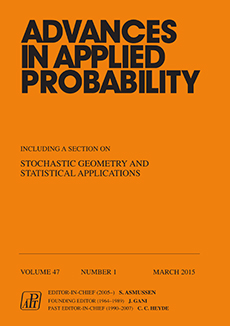Abstract
The modeling of random bi-phasic, or porous, media has been, and still is, under active investigation by mathematicians, physicists, and physicians. In this paper we consider a thresholded random process X as a source of the two phases. The intervals when X is in a given phase, named chords, are the subject of interest. We focus on the study of the tails of the chord length distribution functions. In the literature concerned with real data, different types of tail behavior have been reported, among them exponential-like or power-like decay. We look for the link between the dependence structure of the underlying thresholded process X and the rate of decay of the chord length distribution. When the process X is a stationary Gaussian process, we relate the latter to the rate at which the covariance function of X decays at large lags. We show that exponential, or nearly exponential, decay of the tail of the distribution of the chord lengths is very common, perhaps surprisingly so.
Citation
Yann Demichel. Anne Estrade. Marie Kratz. Gennady Samorodnitsky. "How fast can the chord length distribution decay?." Adv. in Appl. Probab. 43 (2) 504 - 523, June 2011.
Information





